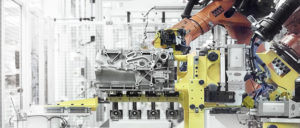Extend Equipment Life with Good Oil Filtration
21 Nov 2018, Posted by in Industry Information This article was written by Adam McMurtrey, Industrial Field Engineer with ExxonMobil Fuels & Lubricants Company.
This article was written by Adam McMurtrey, Industrial Field Engineer with ExxonMobil Fuels & Lubricants Company.
75% of all industrial equipment failures are linked to oil contamination. Therefore, maintaining proper oil cleanliness with the right types of filters is critical to the success of any manufacturing operation. Oil contamination from particulate accelerates the rate of component wear and can lead to premature component failure.
As a result of improved filtration, studies show that improving filtration, as measured by the International Organization for Standardization (ISO) cleanliness code, can extend the life of manufacturing equipment by 1.3 to 3 times or more.1 Additionally, as the oil is cleaned through proper filtration, it is common to extend the life of the oil as well.
Ensuring the cleanliness of the oils and lubricants you’re using can help mitigate these issues and lead to longer equipment life, less unscheduled downtime, and reduced maintenance costs.
Oil cleanliness is measured using the International Organization for Standardization (ISO) cleanliness code to measure particle count per milliliter of oil for particles 4, 6, and 14 micron in size. This ISO code is expressed in 3 numbers: 16/14/11. When filtering your lubricant, you remove particles in the oil of all sizes.
Effective oil filtration can be accomplished on almost all types of manufacturing equipment (e.g. pumps, gear boxes, combustion engines, compressors, vacuum pumps, hydraulics, etc.) To extend the life of equipment throughout your facility, an important component is care for the oil in machines. Oil filters are designed to remove contaminants from oil while it circulates through the host machine. This post will share a basic understanding of filter components, highlighting how these critical devices work and what operators should consider when selecting a filter.
Filtration components
A discussion of oil filters should start with the filter media, which is actual material used to capture a contaminant. It is typically in sheet form, folded to expose maximum surface area. The most common media include wire mesh, cellulose, fiberglass or other synthetic materials.
The type of filter media to be used depends on the filtration design. There are two common types of filters:
-Full-Flow Filters: Draw all the oil through the filter media
-Bypass Filters: Filter a fraction of the oil at a finer size of contaminant than full-flow, requires synthetic media types such as cellulose that are better at trapping small contaminants.
We recommend you work with your filter OEM, equipment builder or lubricant supplier to understand which filtration design and filter media type is best for your equipment.
Filter efficiency
In addition to filtration design and media type, operators need to consider filter efficiency. Filter efficiency refers to a measure of a filter’s ability to collect and retain particles of a specific size, and can be expressed using the nominal, absolute or beta ratings – the most reliable of which is the beta rating.
-Nominal rating: Value indicated by the filter manufacturer based on weight percent removal. Not a reliable measure of filter efficiency as results are not reproducible.
-Absolute rating: Indicates the diameter of the largest hard spherical particle that will pass through a filter under specified test conditions. This rating identifies the largest opening in the filter element, and it does not tell you much about the filter’s ability to keep the fluid clean.
-Beta rating: Determined by the number of particles that pass through a filter even though they are sized above the micron rating, expressed as a beta ratio. Beta ratios are often expressed as an efficiency percentage to more clearly indicate a filter’s ability to control contamination:
βx = number of upstream particles greater than (x) microns / number of downstream particles greater than (x) microns.
Efficiency % = [(β – 1) / β] x 100.
Example: if a 5-micron filter element has 1,000,000 particles and allows 1,000 particles through, its Beta ratio is:
1,000,000 (Before Filter) / 1,000 (After Filter) = β1000.
Efficiency % = [(1,000 – 1) / 1,000] x 100 = 99.9% effective.
In addition to size and efficiency, operators must consider a filter’s dirt-holding capacity (DHC). This refers to the total amount of contaminants that may be trapped by the filter and is related to the physical size of the filter.
Why all of these filter fundamentals so important?
We often hear operators in the field describe their filter size, but they don’t always then consider that filter’s beta rating and dirt holding capacity. Without this understanding, operators who think they’re saving money could in fact be losing money over the long-term.
For example, cheaper filters of a given size have lower efficiency and DHC. Depending on the application, this reduced efficiency can lead to poor filtration, which could in turn impact equipment performance. That’s why it’s critical to select the right filter for the job. Operators should work with their equipment OEM, filter OEM or lubricant supplier to determine which filter is best suited for the application.
Selecting the proper filtration to extend the life of equipment is an investment in your facility and the future of your company.
Source
1. http://filtroilcalc.punchbuild.com/
About: McPherson Oil is proud to distribute ExxonMobil products in the southeast including Alabama, Arkansas, Florida Panhandle, Georgia, Louisiana, Mississippi and Tennessee.
